AMD Ryzen 5 3600 Review: Why Is This Amazon's Best Selling CPU?
by Dr. Ian Cutress on May 18, 2020 9:00 AM ESTCPU Performance: System Tests
Our System Test section focuses significantly on real-world testing, user experience, with a slight nod to throughput. In this section we cover application loading time, image processing, simple scientific physics, emulation, neural simulation, optimized compute, and 3D model development, with a combination of readily available and custom software. For some of these tests, the bigger suites such as PCMark do cover them (we publish those values in our office section), although multiple perspectives is always beneficial. In all our tests we will explain in-depth what is being tested, and how we are testing.
All of our benchmark results can also be found in our benchmark engine, Bench.
Application Load: GIMP 2.10.4
One of the most important aspects about user experience and workflow is how fast does a system respond. A good test of this is to see how long it takes for an application to load. Most applications these days, when on an SSD, load fairly instantly, however some office tools require asset pre-loading before being available. Most operating systems employ caching as well, so when certain software is loaded repeatedly (web browser, office tools), then can be initialized much quicker.
In our last suite, we tested how long it took to load a large PDF in Adobe Acrobat. Unfortunately this test was a nightmare to program for, and didn’t transfer over to Win10 RS3 easily. In the meantime we discovered an application that can automate this test, and we put it up against GIMP, a popular free open-source online photo editing tool, and the major alternative to Adobe Photoshop. We set it to load a large 50MB design template, and perform the load 10 times with 10 seconds in-between each. Due to caching, the first 3-5 results are often slower than the rest, and time to cache can be inconsistent, we take the average of the last five results to show CPU processing on cached loading.
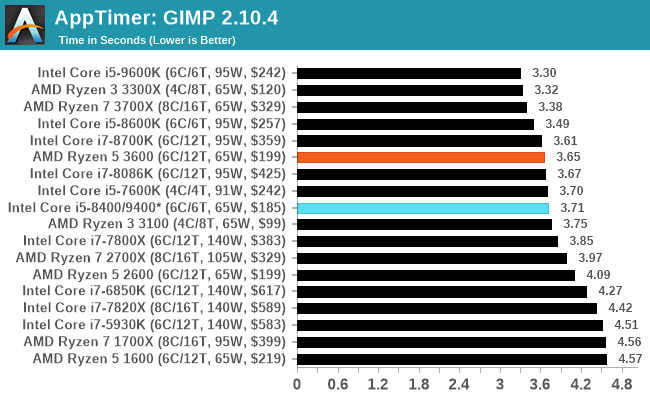
Not much difference here between the i5-8400 and the Ryzen 5 3600.
3D Particle Movement v2.1: Brownian Motion
Our 3DPM test is a custom built benchmark designed to simulate six different particle movement algorithms of points in a 3D space. The algorithms were developed as part of my PhD., and while ultimately perform best on a GPU, provide a good idea on how instruction streams are interpreted by different microarchitectures.
A key part of the algorithms is the random number generation – we use relatively fast generation which ends up implementing dependency chains in the code. The upgrade over the naïve first version of this code solved for false sharing in the caches, a major bottleneck. We are also looking at AVX2 and AVX512 versions of this benchmark for future reviews.
For this test, we run a stock particle set over the six algorithms for 20 seconds apiece, with 10 second pauses, and report the total rate of particle movement, in millions of operations (movements) per second. We have a non-AVX version and an AVX version, with the latter implementing AVX512 and AVX2 where possible.
3DPM v2.1 can be downloaded from our server: 3DPMv2.1.rar (13.0 MB)
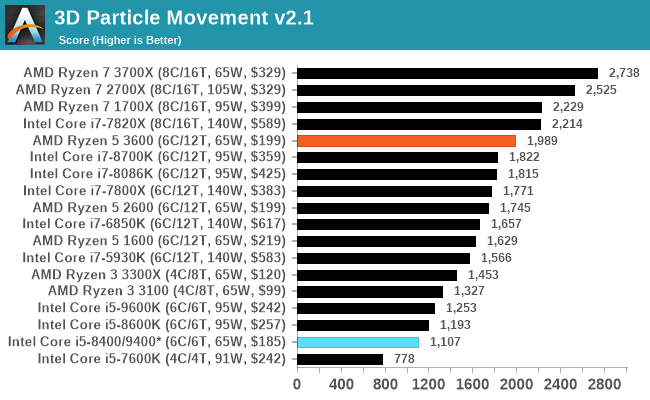
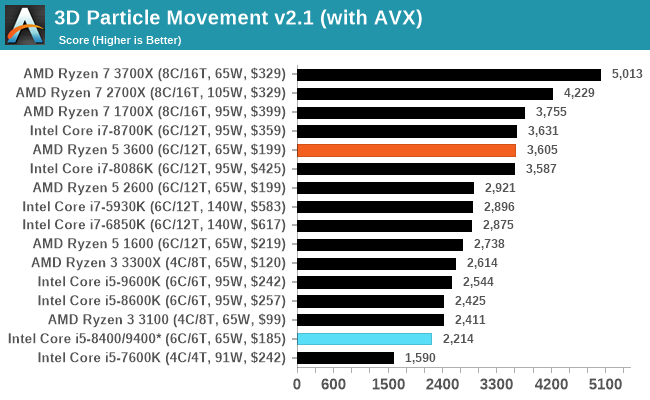
The core deficit comes on strong in 3DPM.
Dolphin 5.0: Console Emulation
One of the popular requested tests in our suite is to do with console emulation. Being able to pick up a game from an older system and run it as expected depends on the overhead of the emulator: it takes a significantly more powerful x86 system to be able to accurately emulate an older non-x86 console, especially if code for that console was made to abuse certain physical bugs in the hardware.
For our test, we use the popular Dolphin emulation software, and run a compute project through it to determine how close to a standard console system our processors can emulate. In this test, a Nintendo Wii would take around 1050 seconds.
The latest version of Dolphin can be downloaded from https://dolphin-emu.org/
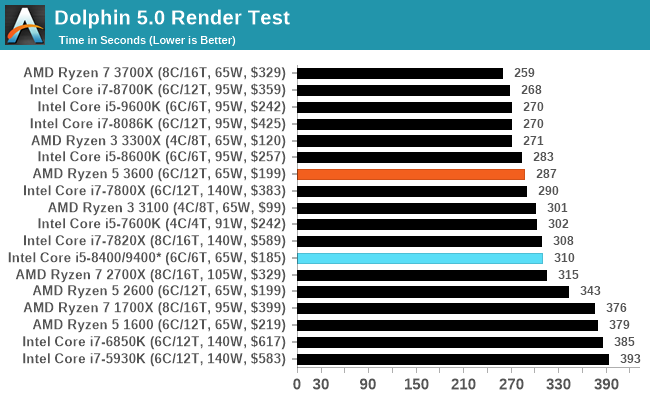
The Ryzen 5 3600 has better single threaded performance, and so the Dolphin emulation scores better with AMD.
DigiCortex 1.20: Sea Slug Brain Simulation
This benchmark was originally designed for simulation and visualization of neuron and synapse activity, as is commonly found in the brain. The software comes with a variety of benchmark modes, and we take the small benchmark which runs a 32k neuron / 1.8B synapse simulation, equivalent to a Sea Slug.
Example of a 2.1B neuron simulation
We report the results as the ability to simulate the data as a fraction of real-time, so anything above a ‘one’ is suitable for real-time work. Out of the two modes, a ‘non-firing’ mode which is DRAM heavy and a ‘firing’ mode which has CPU work, we choose the latter. Despite this, the benchmark is still affected by DRAM speed a fair amount.
DigiCortex can be downloaded from http://www.digicortex.net/
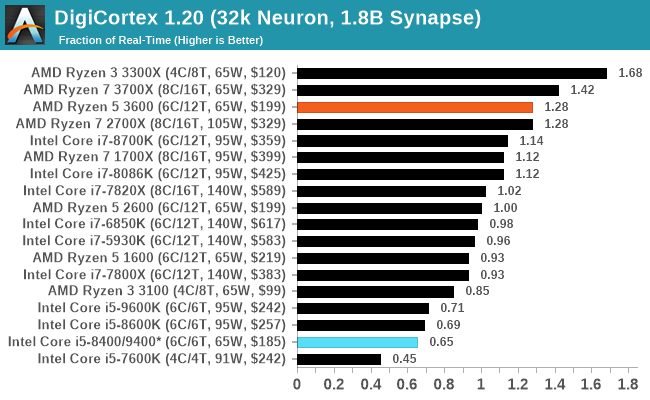
Dual DDR4-2666 doesn't mode well for the Intel processor.
y-Cruncher v0.7.6: Microarchitecture Optimized Compute
I’ve known about y-Cruncher for a while, as a tool to help compute various mathematical constants, but it wasn’t until I began talking with its developer, Alex Yee, a researcher from NWU and now software optimization developer, that I realized that he has optimized the software like crazy to get the best performance. Naturally, any simulation that can take 20+ days can benefit from a 1% performance increase! Alex started y-cruncher as a high-school project, but it is now at a state where Alex is keeping it up to date to take advantage of the latest instruction sets before they are even made available in hardware.
For our test we run y-cruncher v0.7.6 through all the different optimized variants of the binary, single threaded and multi-threaded, including the AVX-512 optimized binaries. The test is to calculate 250m digits of Pi, and we use the single threaded and multi-threaded versions of this test.
Users can download y-cruncher from Alex’s website: http://www.numberworld.org/y-cruncher/
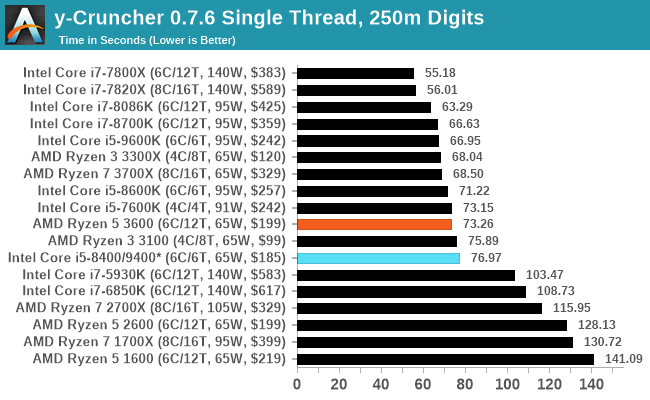

While almost similar in AVX2 in ST mode, the lack of threads again hurts the i5-8400, giving the win to the Ryzen 5 3600. Zen 2 does well here.
Agisoft Photoscan 1.3.3: 2D Image to 3D Model Conversion
One of the ISVs that we have worked with for a number of years is Agisoft, who develop software called PhotoScan that transforms a number of 2D images into a 3D model. This is an important tool in model development and archiving, and relies on a number of single threaded and multi-threaded algorithms to go from one side of the computation to the other.
In our test, we take v1.3.3 of the software with a good sized data set of 84 x 18 megapixel photos and push it through a reasonably fast variant of the algorithms, but is still more stringent than our 2017 test. We report the total time to complete the process.
Agisoft’s Photoscan website can be found here: http://www.agisoft.com/
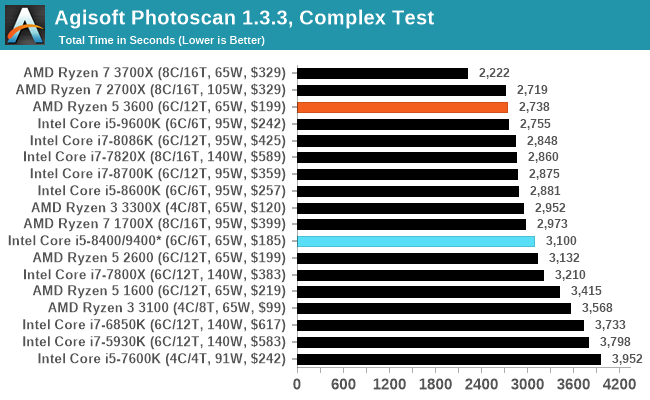












114 Comments
View All Comments
Sonik7x - Monday, May 18, 2020 - link
Would be nice to see 1440p benchmarks across all games, also would be nice to see a comparison against an i7-5930K running which is also a 6c/12T CPUET - Monday, May 18, 2020 - link
Would be even nicer to see newer games. Anandtech reviews seem to be stuck in 2018, both for games and for apps, and that makes them a lot less relevant a read than they could be.Dolda2000 - Monday, May 18, 2020 - link
You exaggerate. The point of a benchmark suite can't really be to contain the specific workload you're going to put on the CPU (since that's extremely unlikely to be the case anyway), but to be representative of typical workloads, and I think the application selection here is quite adequate for that. In comparison, I find it much more important to have more comparison data in the Bench database. There may be a stronger case to be made for games, but I find even that slightly doubtful.MASSAMKULABOX - Saturday, May 23, 2020 - link
Not only that , but slightly older games are much more stable and have most of the performance ironed out. New games are getting patches and downloads all the time, which often affect perfomance. I want to see "E" versions I.e 35/45wThreeDee912 - Monday, May 18, 2020 - link
They already mentioned in the 3300X review they'll be going back and adding in new games like Borderlands 3 and Gears Tactics: https://www.anandtech.com/show/15774/the-amd-ryzen...flyingpants265 - Monday, May 18, 2020 - link
I haven't used AnandTech benchmarks for years. They don't use enough CPUs/GPUs, they never include enough results from the previous generations, which is the most important thing when considering upgrades and $ value.Also, the "bench" tool does not include enough tests or hardware.
jabber - Tuesday, May 19, 2020 - link
Yeah nothing annoys me more than Tech Site benchmarks that only compare the new stuff to hardware than came out 6 months before it. If I see say a new GPU tested I want to see how it compares to my RX480 (that a lot of us will be looking to upgrade this year) than just a 5700XT.johnthacker - Tuesday, May 19, 2020 - link
Eh, nothing annoys me more than Tech Site benchmarks that only compare the new stuff to other new stuff. If I have an existing GPU or CPU and I'm not sure if it's worth it for me to upgrade or stick with what I've got, I want to see how something new compares to my existing hardware so I can know whether it's worth upgrading or whether I might as well wait.Pewzor - Monday, May 18, 2020 - link
I mean Gamer's Nexus uses old games as well.Crazyeyeskillah - Tuesday, May 19, 2020 - link
Just to make this crystal clear, the reason they HAVE to use older games is because all of the PAST data has been run using those games. Most review sites only get sample hardware for a week or less to run the tests then return it in the mail. You literally wouldn't have anything to compare the data to if you only ran tests on the latest and greatest games and benchmarks.When I see people making this complaint I understand that they are new to computers and just want them to understand that there is a reason why benchmarks are limited. Most hardware review sites don't make any money, or if they do, it's enough to pay one or MAYBE two staff members (poorly.) Ad revenue is garbage due to add blockers on all your browsers, and legitimate sites that don't spam blickbaity rumors as news are shutting down. Just look what happened to Hardocp.com, one of the last true honest review sites.
The idea that hardware sites all have stockpiles of every system imaginable and the thousands of hours it would take to constantly setup and run all the new games and benchmarks is pretty comical.